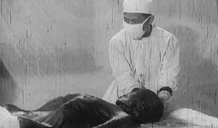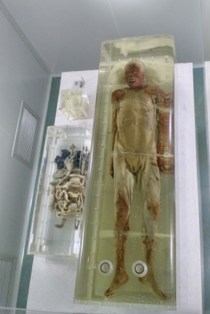
Only known color image of what Sui's body originally looked like

The nearly 2200 year old wet mummy was found in a tomb on Fenghuang Mountain in Jingzhou, China in February 1975. He was found 300 km from the tomb of Xin Zhui.
It took months for the whole tomb to be excavated but by the night of June 8 the final coffin containing Sui's corpse was opened. The corpse was immersed in a reddish fluid, the whole body was naked but visibly intact. On June 9, medical staff performed X-rays and dissections on Sui's corpse. Sui's body is currently on display in the Jingzhou Museum not far from where he was discovered. According to the bamboo tablets excavated from the tomb and the combined seal, the ancient corpse was named "Sui", a native of Yangli, Xixiang City, Jiangling. The age of death was about 60 years old, and the burial time was May Gengchen (June 10, 167 BC) of the 13th year of Emperor Wen of Han.
Mummification[]
Like Xin Zhui, Sui's body was immersed in a reddish fluid which was mildly acidic, traces of cinnabar, a mercury ore, (a red mineral consisting of native mercuric sulfide). The main coffin was placed in several two larger coffins that fit one inside the other. The coffins were then placed inside a massive burial chamber. The burial chamber was then placed in a hole shaped like an underground pyramid, later covered with soil. The hole was dug before Sui's death and was made to ensure his body would never be exposed to the elements. Unlike Xin Zhui, his body wasn't wrapped in layers of silk and linen, nor did his coffins have large advanced paintings.
Studies[]
When unearthed, the corpse was 166cm tall and weighed 52.5kg. The majority of the body was dyed blood red after over 20 centuries of being submerged in the reddish fluid. His limbs were perfectly flexible and his skin was still as elastic as a fresh corpse. The chest and abdomen are whitish green while the top of his head was a slightly lighter tint than the rest of his head. His abdomen was sunken in, revealing his pelvic bones and ribs to a large extent. His mouth was slightly open with his tongue rolled in and the top lip folded up revealing his gums and all 32 teeth. There was partial damage on the skin of the forehead, left arm, and lower limbs. The blood found in his veins was type AB. When the autopsy team made an incision into the chest it was found that although shrunken, all his internal organs were present and intact. They were removed during the autopsy. When the skull was cut open, it was found that the brain was intact, and 12 pairs of cranial nerves were recognizable. While in his mouth, the team found a clay seal lodged in his throat underneath the uvula. The seal, about the size of a die had the character "遂" on it which was his name, Sui.

Sui's body in 1975
Over the nearly 50 years since Sui's discovery, his appearance has changed drastically. His skin has sagged, the blood red tint that once covered most of his body has mostly faded away and his abdomen has a wrinkly appearance.
Today, his body is currently housed in the Jingzhou museum with his internal organs stored beside him.
Pathology[]
When Sui was alive he was was suffering from a variety of diseases, including pleurisy, pericarditis, and cholecystitis. He ultimately died at around age 60 of a chronic gastric ulceration complicated by perforation, resulting in peritonitis combined with widespread bleeding.
External Links[]
http://www.hbjzszx.gov.cn/jzzx/jingchuwenshi/2013/0104/1578.html
